What Is Escarole?
Escarole is a leafy green loved in Mediterranean and Italian cooking. It’s known for its unique bitterness and health benefits. This guide will explore escarole’s special qualities, its nutritional value, and how to use it in tasty dishes.
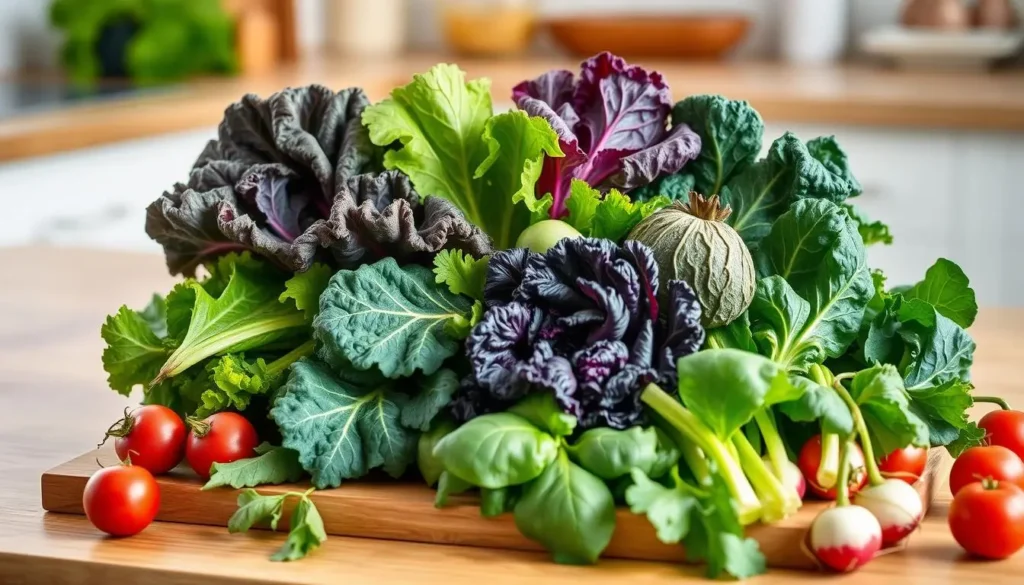
Key Takeaways
- Escarole is a nutrient-dense, bitter leafy green with origins in the Mediterranean region.
- It can be used in a wide range of recipes, from salads and soups to sautéed and braised dishes.
- Escarole is a rich source of vitamins, minerals, and fiber, making it a healthy addition to any diet.
- Escarole can be substituted for other greens like arugula, chard, or kale in many recipes.
- Properly selecting and storing escarole is key to enjoying its optimal flavor and texture.
Introducing : The Versatile Leafy Green
Escarole is a leafy green from the chicory family. It’s related to endive and frisee. It has a unique, slightly bitter taste and sturdy leaves. These leaves are great for many dishes.
Escarole comes from the Mediterranean. It’s a key ingredient in Italian and Mediterranean cooking.
Escarole’s Unique Attributes and Origins
Escarole tastes different from other bitter greens like chicory. Its leaves are pale yellow-green to dark green. They have a lace-like texture that makes dishes look good.
Escarole grows well in many climates. This makes it popular in many Italian dishes.
“Escarole is a versatile leafy green that adds depth and complexity to a wide variety of recipes. Its slightly bitter undertones complement rich flavors beautifully.”
Escarole has been grown in the Mediterranean for a long time. It was first used by ancient Romans and Greeks. Now, it’s a favorite in Italy, Spain, and France.
Escarole: A Nutritional Powerhouse
Escarole is a vitamin-rich vegetable that’s packed with health benefits. Its vibrant leaves are full of essential nutrients. It’s a nutritional powerhouse that should be in every healthy kitchen.
Escarole is known for its high vitamin A content. Just one cup gives you nearly 100% of the daily recommended intake. Vitamin A is key for eye health, immune function, and skin health.
It’s also a great source of vitamin C. One serving has over 25% of the daily recommended amount. Vitamin C boosts the immune system and protects cells.
| Nutrient | Amount per Serving | % Daily Value |
|---|---|---|
| Vitamin A | 4,630 IU | 92% |
| Vitamin C | 15 mg | 25% |
| Vitamin K | 104 mcg | 130% |
| Folate | 46 mcg | 12% |
| Calcium | 75 mg | 8% |
| Fiber | 2.4 g | 10% |
Escarole is also rich in dietary fiber, with over 2 grams per serving. This fiber-rich content supports digestive health and helps you feel full. It’s great for any balanced diet.
Escarole is a true nutritional powerhouse among leafy greens. Adding it to your meals brings many health benefits. It supports your overall wellbeing.
Distinguishing Escarole from Other Greens
Escarole looks similar to other chicory family members like endive, frisee, and radicchio. But it has its own special traits. It has bigger, wavier leaves and a milder taste, less bitter than its relatives.
Escarole vs. Endive, Frisee, and Chicory
Knowing the differences between these leafy greens helps you pick the right one for your dishes:
- Escarole – Broad, wavy leaves with a mildly bitter taste. Holds up well to cooking.
- Endive – Tightly packed, pointed leaves with a more pronounced bitter flavor. Better suited for raw preparations.
- Frisee – Curly, delicate leaves with a slightly sweet, peppery taste. Adds texture and crunch to salads.
- Chicory (Radicchio) – Compact heads with vibrant red leaves and an intense bitterness. Often used for its striking visual appeal.
Learning about each bitter green‘s unique qualities lets you use them in your cooking. This way, you can make your meals more enjoyable.
“Escarole’s milder bitterness and sturdy leaves make it a versatile choice for both raw and cooked preparations.”
The Delightful Bitterness of Escarole
Escarole’s unique taste comes from its bitter flavor. This leafy green, part of the bitter greens family, is a key ingredient in Italian cooking. Its bitter notes add depth and complexity to many dishes, making them more balanced and enjoyable.
The bitterness in escarole comes from natural compounds in its leaves. These compounds give it an earthy, robust, and slightly pungent taste. This bitterness can make a dish more sophisticated and nuanced, pleasing those who appreciate complex flavors.
“The bitter notes of escarole are like a symphony, adding depth and harmony to the overall flavor composition of a dish.”
In Italian cooking, escarole is a beloved ingredient. Its bitterness complements the rich flavors of Mediterranean cuisine. It’s great in soups, stews, salads, and sautéed dishes, adding a refreshing contrast to rich flavors.
If you love escarole or are new to it, exploring its bitterness is exciting. Escarole’s complexity can take your Italian cooking to new heights. It opens up a world of flavors that will impress your taste buds.
Selecting and Storing Escarole
Choosing fresh escarole is all about vibrant, crisp leaves. They should be free from wilting or discoloration. This leafy green needs the right storage to keep its texture and taste. With the right methods, you can enjoy escarole for up to five days.
To store escarole, wrap the leaves in a damp paper towel. Then, put them in a plastic bag or airtight container in the fridge. This keeps the moisture in, preventing the fresh produce from drying out. You can also store it in a sealed plastic bag, squeezing out air before sealing.
By using these storage tips, your escarole will stay fresh and tasty. It’s perfect for many dishes like soups, salads, or sautés. Properly stored escarole will be the highlight of your meals.
| Escarole Storage Tips | Recommended Technique |
|---|---|
| Wrapping in Damp Paper Towel | Place escarole leaves in a plastic bag or airtight container, with a damp paper towel to retain moisture. |
| Storing in Sealed Plastic Bag | Gently squeeze out any excess air before sealing the bag to prevent wilting. |
| Maximum Storage Duration | Properly stored escarole can last up to 5 days in the refrigerator. |
Escarole in Mediterranean and Italian Cuisine
Escarole is a key ingredient in Mediterranean and Italian cooking. It’s loved for its unique taste and texture. It makes many dishes better, both old and new.
Classic Dishes Featuring Escarole
Escarole pairs well with the strong tastes of Mediterranean and Italian food. It’s great in soups, sautés, and braises. Here are some famous dishes that use escarole:
- Italian Wedding Soup – A hearty soup with escarole, meat, veggies, and pasta.
- Escarole and Beans – A simple dish with escarole, garlic, olive oil, and white beans.
- Escarole Salad with Anchovies – A Mediterranean salad with escarole and salty anchovies.
- Escarole Braise – Escarole is slow-cooked with olive oil, garlic, and sometimes wine.
| Dish | Cuisine | Preparation |
|---|---|---|
| Italian Wedding Soup | Italian | Escarole is combined with meat, vegetables, and small pasta in a comforting broth. |
| Escarole and Beans | Italian | Escarole is sautéed with garlic, olive oil, and white beans for a nourishing dish. |
| Escarole Salad with Anchovies | Mediterranean | The bold bitterness of escarole is balanced by the salty umami of anchovies. |
| Escarole Braise | Mediterranean | Escarole is slowly braised with olive oil, garlic, and sometimes white wine. |
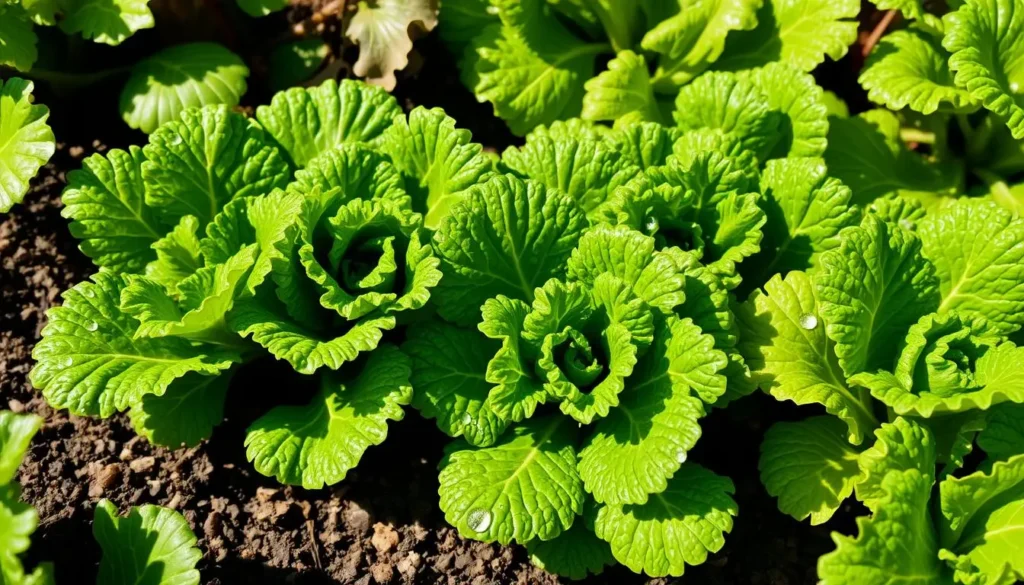
“Escarole is a versatile ingredient that adds both texture and flavor to many classic Mediterranean and Italian dishes.”
Escarole in Salads and Slaws
Escarole is a leafy green with a crisp texture and a slightly bitter taste. It’s great in salads and slaws. Its sturdy leaves can handle different dressings, adding nutrition and a unique flavor to your dishes.
Adding escarole to your salads or slaws can be a game-changer. Its bitter taste complements sweeter or creamier ingredients. This creates a perfect balance of flavors.
Escarole Salad Inspirations
- Toss escarole with apple slices, toasted walnuts, and a tangy vinaigrette for a refreshing salad.
- Combine escarole with roasted beets, crumbled feta, and a citrus-based dressing for a vibrant salad.
- Mix escarole with grilled chicken, avocado, and a creamy ranch-style dressing for a protein-packed salad.
Escarole Slaw Creations
Escarole’s crunchy texture and mild bitterness are perfect for slaws. Shred it and mix with shredded cabbage, carrots, and a tangy-sweet dressing. This slaw is great with grilled meats or fish.
| Escarole Salad Ingredients | Escarole Slaw Ingredients |
|---|---|
| Escarole Apple slices Toasted walnuts Vinaigrette dressing | Escarole Shredded cabbage Carrots Tangy-sweet dressing |
Adding escarole to your salads and slaws boosts nutrition and flavor. Try different combinations to find the perfect mix of bitterness, crunch, and freshness.
Cooking with Escarole: Sautéing and Braising Techniques
Escarole is a versatile leafy green that can be cooked in many ways. It’s great for sautéing and braising, which enhance its flavor and texture. These methods make escarole a delightful addition to any meal.
Sautéing escarole quickly over medium-high heat is key. It softens the leaves and mellows the bitterness. Adding olive oil or butter keeps it moist. It’s perfect with garlic, lemon, and red pepper flakes.
Braising escarole makes it tender and silky. It’s cooked in flavorful liquids like broth or white wine. This method turns the bitterness into a sweet undertone. Braised escarole is great on its own or in dishes like pasta and grain bowls.
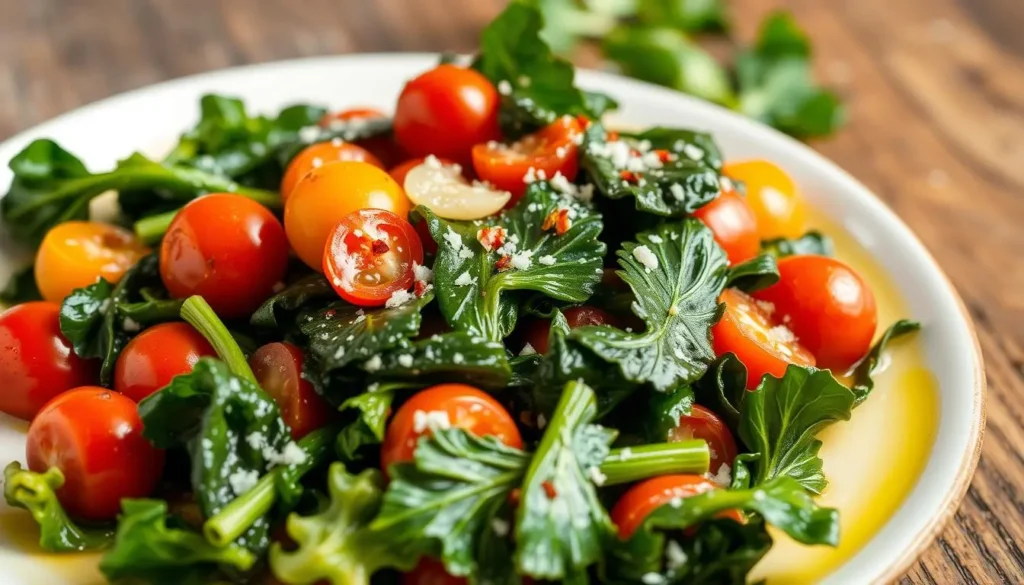
Whether you like quick sautéing or slow braising, escarole is a great choice. It offers a unique taste and texture. Experiment with it to find new ways to enjoy it in your cooking.
Escarole in Soups and Stews
Escarole is great in soups and stews because of its strong leaves and taste. It stays firm even after long cooking times. This makes it perfect for hearty dishes like Italian wedding soup.
Escarole in Italian Wedding Soup
In Italian wedding soup, escarole adds a special touch. It goes well with meatballs, pasta, and broth. Its slightly bitter taste balances the soup’s richness, making it a cozy meal.
Escarole is not just for Italian wedding soup. It also makes other soups and stews better. It pairs well with beans, tomatoes, and root veggies. This makes it a great choice for many winter dishes.
- Escarole adds a nice texture and taste to soups and stews
- The classic Italian wedding soup shows how escarole can enhance savory flavors
- Escarole’s strong leaves keep soups and stews thick
- This leafy green can improve many recipes, from bean dishes to tomato stews
Escarole as a Nutritious Substitute
Escarole is a great choice for those looking for a nutritious leafy green. It can replace arugula, chard, or kale in many recipes. Its strong taste and firm texture work well in salads, sautés, soups, and stews.
Escarole’s bitter taste can be balanced with the right preparation and ingredients. By using escarole instead of other leafy greens, you get a unique flavor and texture. Plus, you still get all the nutrients.
Swap Escarole for Arugula, Chard, or Kale
Here are some tips for substituting escarole with other greens:
- Arugula: Escarole is milder and less peppery than arugula. It’s perfect for salads and pesto.
- Chard: Escarole’s sturdy texture is great for sautés and braises, just like chard. Use it in sautés, stir-fries, and soups.
- Kale: Escarole’s strong leaves make it a good substitute for kale. It works in salads and cooked dishes. Just adjust cooking times.
Adding escarole to your recipes lets you enjoy the nutritional benefits of other leafy greens. You’ll also discover a new and exciting taste.
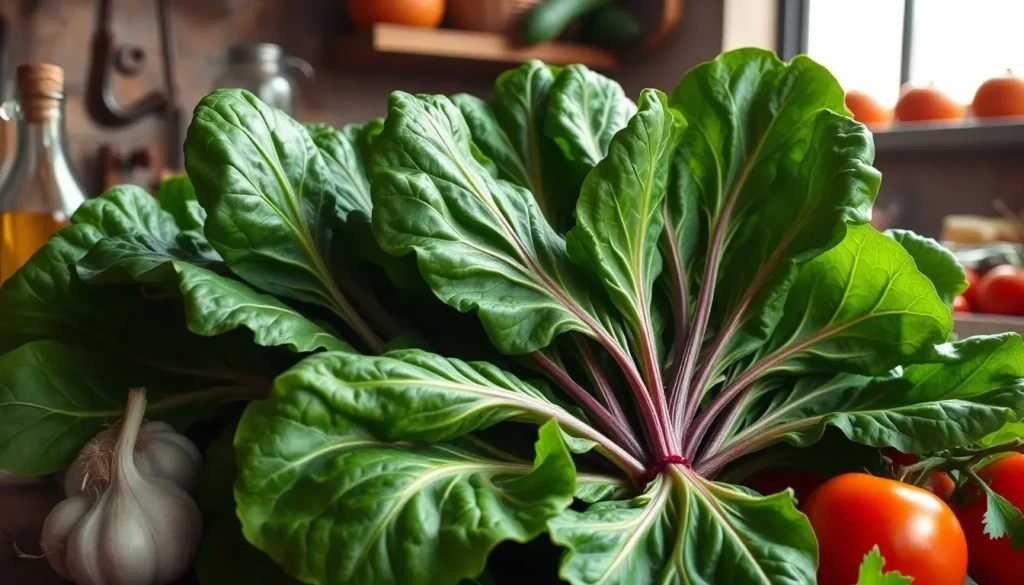
Escarole: A Versatile Ingredient in Recipes
Escarole is great in many dishes, from salads to braises. It works well with strong and light flavors. This makes it a key ingredient for cooks.
Its bitter taste is perfect for Mediterranean and Italian dishes. Try it in escarole and bean soup or escarole-stuffed ravioli. It will make your food even better.
Versatile Escarole Recipes to Try
- Grilled Escarole Salad with Lemon Vinaigrette
- Sautéed Escarole with Garlic and Anchovies
- Escarole and Sausage Stuffed Portobello Mushrooms
- Escarole and White Bean Stew
- Braised Escarole with Tomatoes and Parmesan
Escarole is not just for Mediterranean and Italian food. It’s also great in escarole and apple slaw or escarole and lentil soups. It adds a nice bitterness and crunch.
“Escarole is a game-changer in the kitchen. Its robust flavor and texture make it a standout ingredient in both classic and innovative recipes.”
Whether you’re new to cooking or experienced, escarole is exciting. It lets you get creative in the kitchen. Let your imagination run wild with this unique ingredient.
Grow Your Own Escarole at Home
For those with a green thumb, growing escarole at home is rewarding. This leafy green loves cool weather, perfect for home gardening fans. By growing your own escarole, you get a fresh supply of this healthy veggie.
Start by picking a spot with partial shade and well-drained, fertile soil. Escarole does best in cooler temps. Plant it in early spring or late summer, based on your area’s climate. Plant seedlings or transplants 12-18 inches apart for enough room to grow.
Escarole needs little care once it’s growing. Keep the soil moist but not too wet. Also, remove weeds often to keep nutrients for your plants. Harvest the outer leaves first, letting the inner ones grow for more.
Growing escarole is great for both new and seasoned home gardeners. It’s packed with nutrients and easy to use in cooking. This makes it a top pick for any home chef.
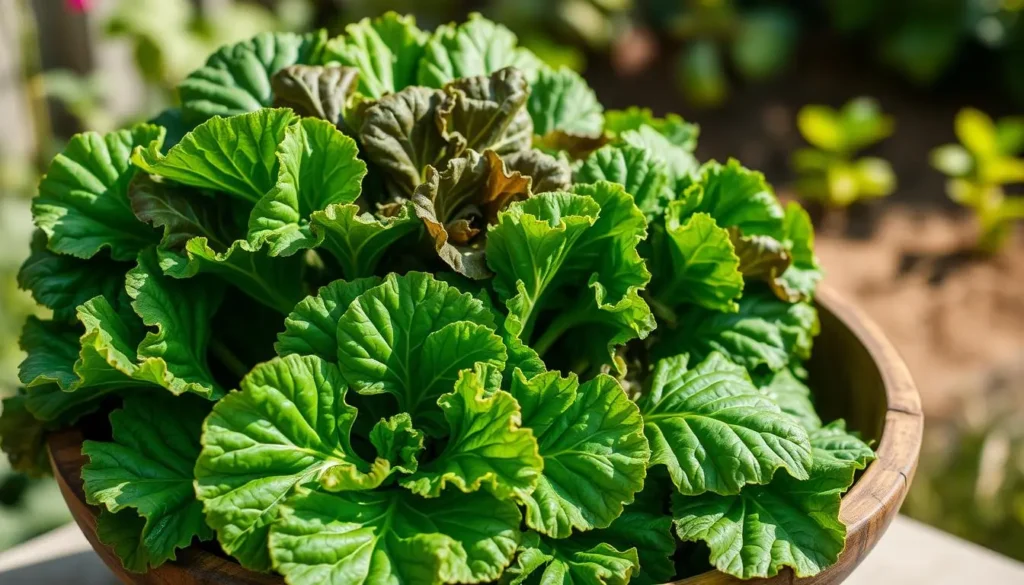
The secret to growing great escarole is choosing the right spot, keeping the soil right, and harvesting often. With a bit of care, you’ll have a big harvest of this tasty and healthy leafy green.
Conclusion
Escarole is a standout leafy green that should be in every kitchen. It brings a unique taste and is super versatile. Plus, it’s packed with nutrients, making it great for many dishes.
From Mediterranean to Italian cooking, escarole can do it all. It’s perfect for salads, soups, and more. The possibilities are endless.
Learning about escarole opens up a world of tasty and healthy meals. It’s great for adding more greens to your diet or trying new flavors. Escarole is definitely worth trying.
Start exploring escarole and see how it can improve your cooking. It’s full of nutrients and has a unique taste. Let escarole guide you to making amazing dishes that are good for you and delicious.
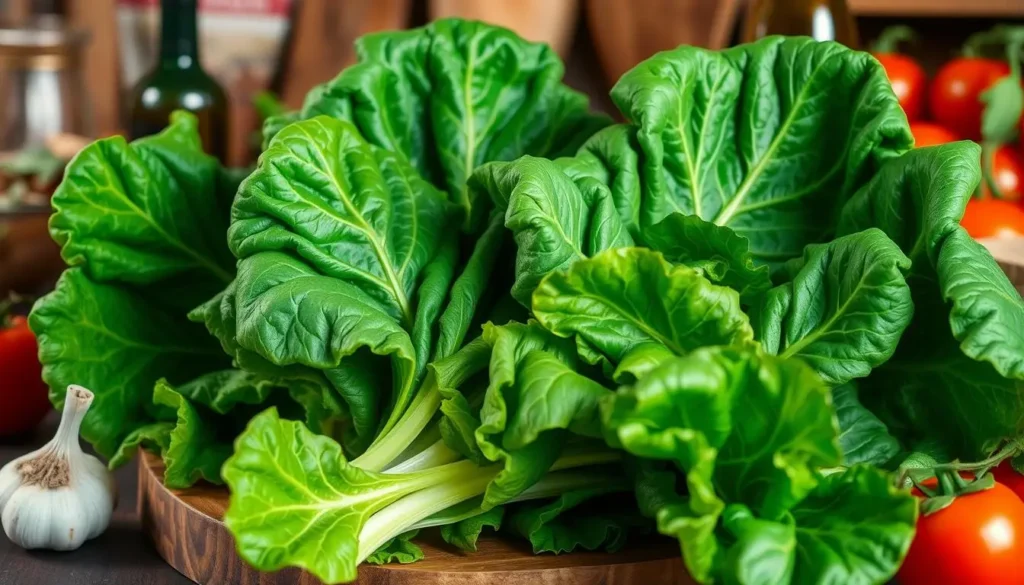
FAQ
What is escarole and what are its unique attributes?
Escarole is a leafy green from the chicory family. It’s related to endive and frisee. Its leaves are sturdy and wavy, with a slightly bitter taste. This makes it great for many dishes.
It comes from the Mediterranean and has been loved in Italian and Mediterranean cooking for ages.
What are the health benefits of incorporating escarole into my diet?
Escarole is full of vitamins and minerals. It’s rich in vitamins A, C, and K, and also has folate, calcium, and fiber. Eating escarole can boost your immune system and help your bones.
How does escarole differ from other bitter greens like endive, frisee, and chicory?
is related to other chicory greens but is unique. It has bigger, wavier leaves and a milder taste. Knowing the differences helps you pick the right green for your recipes.
How can I best utilize the bitterness of escarole in my cooking?
Escarole’s bitterness is a key part of its charm. It adds depth to dishes. Balancing it with other flavors can make your recipes more complex and interesting.
What are some classic Mediterranean and Italian dishes that feature ?
Escarole is a staple in Mediterranean and Italian cooking. It’s used in soups, sautés, and more. Its flavor and versatility make it a favorite in many traditional and modern recipes.
How can I incorporate e into salads and slaws?
Escarole is great in salads and slaws. Its crisp texture and slight bitterness are perfect for contrasting with sweeter ingredients. Adding escarole to your salads and slaws can boost nutrition and flavor.
What are some effective cooking techniques for preparing ?
You can cook escarole in many ways. Sautéing it quickly in oil or butter softens the leaves and mellows the bitterness. Braising makes the leaves tender and silky, blending the flavors.
How can I use in soups and stews?
Escarole is great in soups and stews. Its leaves hold up well to long cooking times. It adds a hearty texture and flavor to dishes like Italian wedding soup.
Can I use escarole as a substitute for other leafy greens in my recipes?
Yes, escarole is a good substitute for other leafy greens. Its texture and flavor work well in salads, sautés, and more. It offers a similar nutritional profile and a unique taste and texture.


2 thoughts on “What Is Escarole and How Can I Use It? | Leafy Guide”